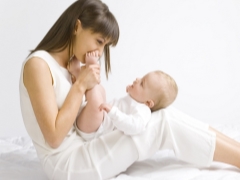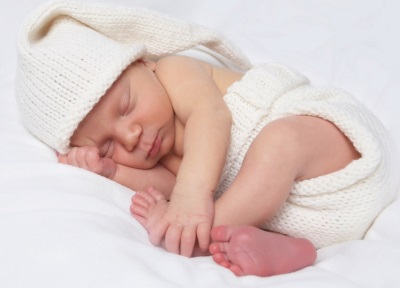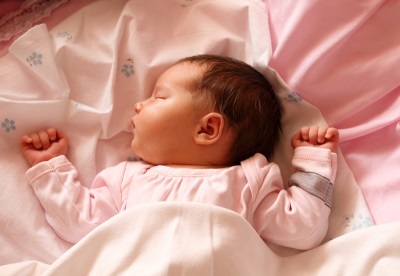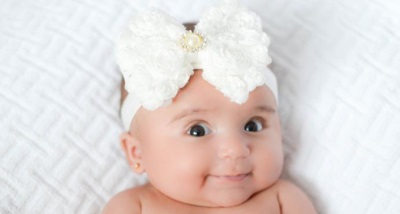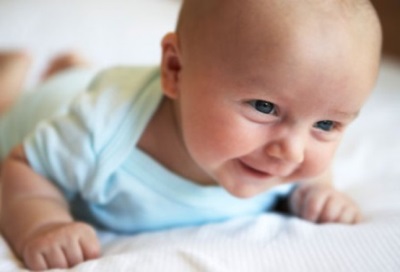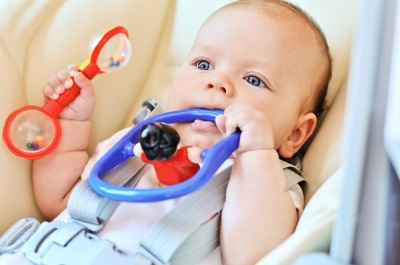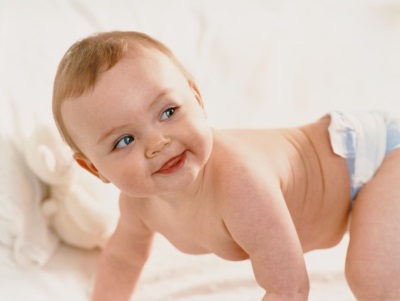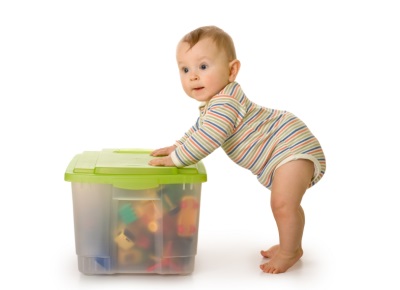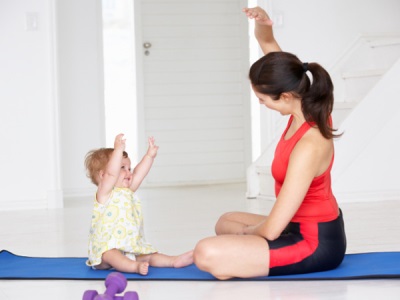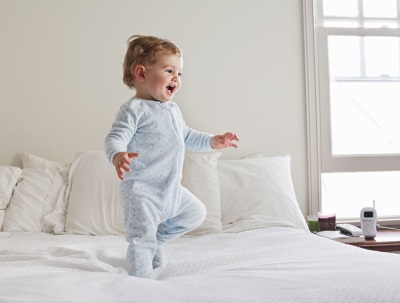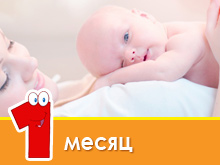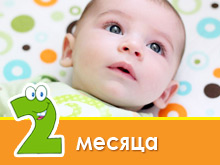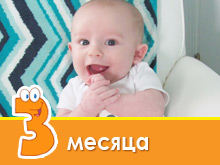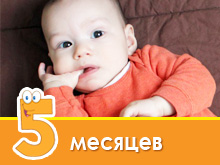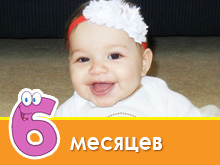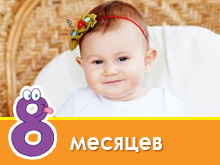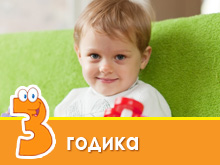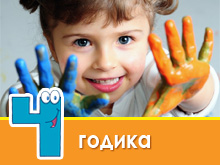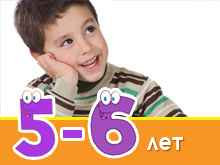Child development in months to a year
During the first 12 months the child develops especially actively. And although all the little ones go through different stages of development according to their individual schedule, there are some common signs common to most children of the same age. To determine whether the baby is developing normally and whether it is necessary to inform the pediatrician about any problems, parents should know how to grow and what skills the baby acquires in the first year of life.

Child development indicators
First of all, assess the physical development of the baby, the indicators of which are:
- The weight of the child. This indicator is very important for the baby. In the first days after childbirth, the baby loses a bit of weight in normal conditions, but then it only has to add. Usually, the child's weight becomes twice the mass at birth by 6 months of age and three times more by 12 months.
- The growth of the baby, the indicators of the circumference of the head and chest. During the first year, the child grows in length by about 25-27 centimeters, while in the first months the baby grows especially actively, adding 3 cm of growth, and in the second half of the year - only 1-2 cm each month.
- Static and motor functions. Assess the child's ability to hold his head, grab and hold objects, roll over, sit, crawl, stand on legs, walk and others.
- The presence of teeth. The first teeth (incisors at the bottom) usually appear by 6 months of age. The normal number of teeth for the baby is calculated by subtracting the number from the age in months. By the age of most babies, 8 teeth are cut.
Emotional and mental development of the crumbs is estimated by the following indicators:
- Emotions baby. A monthly baby begins to smile, and at 3 months of age he becomes animated when an adult applies. The grown-up tot shows more and more emotions, both negative and positive.
- Speech development. The first sounds, which makes a crumb, are grunting and sniffing, but by the end of the first month the baby begins to roar. As the baby grows, it first begins to babble, and then utters its first words. By the year in the speech of the baby have an average of about ten words.
- Manipulations with toys and games. At first, the baby grabs the toys reflexively, but later begins to capture them purposefully. Growing up, the peanut studies their properties and learns the different ways of playing games.
- Understanding adult speech and intonation - starts at 6 months of age. The child begins to react to the words of an adult, if they are accompanied by gestures, learns his name, finds with his eyes familiar objects in response to an adult's question.
Calendar-table of child development from birth to one year
Every month, the crumb not only adds weight and body length, but also pleases parents with new skills. Traditionally, the development of a child of the first year is celebrated monthly. The main features of the development of the child, we have collected in this table:
Age and physical performance | Skills |
At the time of birth Height (length) - 49-50 cm Weight - 3200-3300 g Head circumference - 34-34.5 cm Chest circumference - 32-34 cm | Moves legs and arms while awake. Flinches and starts blinking at sharp sounds. Responds to irritation cry. |
1 month Height (length) - 54-55 cm Weight - 4200-4500 g Head circumference - 36.5-37 cm Chest circumference - 36-36,5 cm | He tries to raise his head in a position on his stomach and hold it for 5 seconds. Monitors moving bright objects and the face of an adult. Reacts to harsh sounds. Replies smile. Starts to boom. |
2 months Height (length) - 57-58 cm Weight - 5100-5600 g Head circumference - 38-39 cm Chest circumference - 38-39 cm | Holds the head for a long time. Turns on the sound of an adult's speech. Captures objects reflexively. Actively interested in the outside world. Agukaet. |
3 months Height (length) - 60-61,5 cm Weight - 5800-6400 g Head circumference - 39.5-40.5 cm Chest circumference - 40-42 cm | In the vertical position holds his head well. Considers subjects for a long time. Makes a variety of sounds. With the support under the arms leans legs. In position on the abdomen lifted on the forearms. Turns to the side with the back. Emotionally responds to the conversation, shows discontent with a loud cry. Sucks fingers or cam. |
4 months Height (length) - 62-64 cm Weight - 6400-7000 g Head circumference - 40.5-41.5 cm Chest circumference - 41.5-42 cm | Confidently raises his head, lying on his tummy. Handles her mother's breast or bottle during feeding. At games, he laughs and smiles. A long walk Grab hands hanging items. Turns from the back to the stomach. In position on the abdomen rises with a palm rest. Lying on the back, raises his head and shoulders. |
5 months Height (length) - 64-66 cm Weight - 6900-7500 g Head circumference - 41.5-42.5 cm Chest circumference - 43-44 cm | Recognize mom and other loved ones. Consciously sees off the subject. Turns from tummy to position on the back. Captures and holds items with both hands. Takes the object from the hands of an adult Sits with support. For a long time chanting. Responds to the heard ringing and songs. Examines the pictures. |
6 months Height (length) - 66-67,5 cm Weight - 7300-7900 g Head circumference - 42-43 cm Chest circumference - 44-45,5 cm | Sits without support. Pulls hands to the subject, which is interested. Raises a toy that fell out of the hands. Tries items "tooth". Begins to crawl. Learning to eat from a spoon. Starts to utter syllables. He tries to stand on his feet, holding on to the support. Responds to the name. Listening carefully to an adult. Looks at the subject about which the adult speaks. |
7 months Height (length) - 67-69 cm Weight - 7600-8300 g Head circumference - 43-44 cm Chest circumference - 45-46,5 cm | Creeps well and sits. It stands with support for both hands. Holds an irregularly shaped object in your hand. Long playing with toys, studying their properties. Drinks from a mug with the help of an adult. Trying to sit down. Shows part of the body. |
8 months Height (length) - 69-70,5 cm Weight - 7900-8600 g Head circumference - 43.5-44.5 cm Chest circumference - 46-47 cm | Looking for a toy that fell. Shifts an item from one pen to another. Rises, holding the support. Creeps quickly. Sits down, lies down, steps over objects. Babbling with intonation. Rejoices to other children. Shows familiar items, answering the question "where?". Independently holds solid food (crackers, cookies). Afraid to part with mom. |
9 months Height (length) - 70-72 cm Weight - 8200-8900 g Head circumference - 44-45 cm Chest circumference - 47-48 cm | Trying to stand and take the first steps. Mimics other children. Reaching for the subject of interest and trying to get it. Consciously manipulates toys. Shows the body parts in humans and toys. Tears and crumples sheets of paper. Holding on to the support, dancing to the music. |
10 months Height (length) - 71.5-73 cm Weight - 8500-9200 g Head circumference - 44-45,5 cm Chest circumference - 47-48 cm | Begins to take small objects with your fingers. Sticks his fingers in the holes, opens the boxes. Playing hide and seek. He walks with support for two adult hands. It can climb and descend the stairs (3-4 steps). Understands the requests of an adult. Repeats for adults gestures and sounds. Mimics the voices of animals. Waving his hand at parting and meeting. He tries to eat himself with a spoon. |
11 months Height (length) - 73-74,5 cm Weight - 8700-9400 g Head circumference - 44.5-46 cm Chest circumference - 48-49 cm | Independently worth it. He walks with support for one hand. Raises objects without squatting (bends down). Able to sit down without support. Collects a pyramid. Folds cubes. Begins to say “lightweight” words. Plays in palms. Vividly reacts to a stranger or new toys, as well as to praise. Interested in books and musical toys. |
12 months Height (length) - 74-76 cm Weight - 8900-9600 g Head circumference - 45-46 cm Chest circumference - 48-49 cm | Trying to walk on their own. Rises from squatting position. Independently drinks from a cup. May refuse unloved food. Bites off cookies and other solid food. Understands the words "can not" and "can." It recognizes animals and shows them in the picture and on the street. Knows how to use certain items. Say 10-15 words. |
About what the famous pediatrician E. Komarovsky thinks about the early development baby, see the next video.
Newborn
Immediately after birth, the baby begins to adapt to the new conditions of life, and his parents - to their new responsibilities. The main need of the baby during this period is physical contact with the mother.
- The crumb spends most of the time in a dream. The baby’s sleep is deep when the body of the baby is completely relaxed and the eyes are closed, as well as shallow, in which the baby’s limbs can move and the breathing is uneven. When feeding a newborn can nap.
- The baby responds with crying to cold, hunger, pain, wet diaper, heat and other irritants.
- In a child, unconditional reflexes of grasping, searching, swimming, walking and sucking are noted. Their presence must be checked by pediatricians. Some of these reflexes disappear with time.
- During this period, the nutrition of the baby is very important, the best option for which is mother's milk. The baby eats very often (usually with an interval of 1-2 hours), including at night.
- If you put the baby on the tummy, the baby will try to raise his head. Some kids do it for a few seconds.
- The child can hold his gaze on a stationary object, as well as respond to the appearance of a sharp sound.
Watch the following video about what happens to the baby in the first month after birth.
1 month
Behind the first month the child grows an average of 3 cm and adds about 600 g of weight.
- The crumb already consciously smiles at the adult and tries to hold his head, but for now he can only do this for a few seconds.
- The little one can already stop his gaze not only on fixed, but also on moving objects, if they are bright and large.
- Sharp loud noises cause a pronounced reaction in the month-old toddler - usually the child shudders or stops, but it may start to cry.
- If you come to the baby and smile at him, you will cause a revival in the baby. The child will smile back and begin to move the arms and legs.
- The baby begins to say in response to conversations and the smile of an adult sounds resembling "ha", "gee" or something similar, so this "speech" of a toddler is called agukaniem.
2 months
In second month compared to the weight and height of 1 month, the toddler becomes more by 700-1000 g (average 800 g) and 3 cm.
- The baby begins to spend more time in the waking state. On average, the baby does not sleep at about 15 minutes per hour. At this age, babies still do not know how to distinguish between night and day, so they can stay awake at night.
- The two-month-old peanut has already learned to hold the head for about a minute, and also to roll over from the side position to the back. If you put the crumbs in your palm finger, the baby firmly grasp it. The tone of the handles is almost gone, but in the legs is still preserved.
- The baby at 2 months actively gulits, fixes the eye on both stationary and moving objects. Having seen a bright subject, the crumb freezes. Of all the sounds heard, the peasant already knows how to single out a person’s speech, and in response to the appeal and smile of an adult, the baby also smiles.
3 months
Behind third month The life of a baby adds an average of 750 grams and grows 3 cm in length. The baby is awake longer - about 1-1.5 hours. At this time, with the baby you need to talk, hug him, show everything around.
- The kid confidently holds his head if held vertically. Lying on the tummy, the baby rests against the surface with elbows and forearms and raises its head. If you take a toddler under the arms, it will firmly rest on the surface of the legs. Also, the baby begins to turn from position on the back to the flank.
- The child is already a long time and intently examines objects in their environment. He is attracted by bright toys and everything that happens around him.
- In addition to the vowel sounds, consonants appear in the child’s speech. The baby begins to show different emotions - if he is unhappy, she cries loudly, and when she is happy, she moves her hands, smiles, makes sounds, laughs. In this case, the crumbs' emotions become understandable to parents.
- In the palms of the crumbs is no hypertonus. The child pulls the handles to the toys, trying to grab them. He also tries to study his body - he touches his face, sucks pens, catches legs.
4 months
TO four months old compared to the previous month, the child gains an average of 700-800 g of weight and grows 2.5 cm in length. The baby has already developed a certain mode of the day, and sleep at night is longer.
- Scarce has already learned not only to keep his head well and turn it to the side, but also to roll over on his tummy from the position on the back. Lying on her stomach, the baby can already lean on her palms and rise to look at everything around. When the crumb lies on his back, he also lifts his head and shoulders. So the baby makes the first attempts to sit down.
- The crumb already manages his hands well, grabs toys that hang, feels them, pulls in his mouth, throws, knocks. When a baby eats, it wraps its arms around the mother's breast or bottle.
- The baby gulits for a long time, responds with a smile or a laugh to the speech of an adult, music, his own reflection in the mirror. Mom may notice that some babies like the toys more.
- Feed-fed kharpuzam begin to be fed, introducing the baby with porridge or vegetables. Breastfed babies still eat only breast milk, which is enough for them.
5 months
Behind fifth month baby's height increases by 2-2.5 cm, and weight - by about 600-700 grams.
- Physical activity crumbs increases. Back-to-tummy coups are added back-coups from a prone position to the back. Many tots at 5 months of age can already sit, but at the same time the back of the child is bent. With the support under the arms, the crumb is already on straight legs.
- If an adult gives a five-month-old toddler a toy, the baby takes her hands. At the same time, the baby can hold objects in both hands for at least 20 seconds.
- A child of 5 months already reacts differently to the faces of loved ones and strangers. He learns my mother's voice, and at the same time she distinguishes whether she speaks affectionately or strictly.
- When a five-month-old baby is awake, he longs for a while, pronouncing the sounds of a chant.
6 months
Behind sixth month The baby adds about 600 grams of weight and about 2 cm of height.
- The half-year-old peanut has already learned to sit without any support, but many kids do not know how to sit on their own for the time being. Many toddlers at this age start to get around the room crawling, but some only learn to stand on all fours and sway. If you take the baby for both hands and slightly tighten, the baby will rise to its feet. Holding the baby by the chest, the parents notice the baby’s first attempts to cross the legs.
- A child can easily grab items, and if a toy falls out of his hand, he raises it. He can shift the object from one pen to another.
- A baby of six months babbles a lot and begins to pronounce syllables, but so far they have no semantic meaning. Parents can hear from the toddler "ma", "yes", "ba" and other syllables, the number of which increases daily.
- A six-month-old child already knows his name, and can also look for a large object that his mother tells him about.
- Many children of six months are wary of strangers or even fear strangers. At the same time, they like other children. They are watching with interest and even begin to repeat their actions.
- At 6 months of age, some babies get their first teeth. They cut into the lower jaw.
- A six-month baby can already eat from a spoon, removing the food with his lips. It is from the age of six months that they begin the introduction of complementary foods for babies who were previously fed only mother's milk. In formula-fed babies, the diet already expands significantly by this age.
7 months
Behind seventh month The child's life gains from 400 to 600 g, and his height increases by 2 centimeters.
- A seven-month-old peanut sits confidently and crawls rather quickly. If you hold the baby by both hands, he stands steadily and tries to step over with his feet.
- At this age, the baby for a long time occupy toys. It is interesting for the child to study them, to shift them from one hand to another, to throw, to break, to open and to carry out other manipulations.
- A child of 7 months not only knows how to eat from a spoon, but also learned to drink from a mug, although the adult itself is still holding the mug itself.
- A seven-month-old baby listens attentively to the speech of adults, if he is told about a familiar object, which is in a room in a permanent place, then the baby will find the object with his eyes. Also, the child is already familiar with his mirror reflection and is able to show some parts of the body.
- Seven months is the age of the first teeth eruption in most children. For some babies, only the first incisors appear below, and some already have 2 teeth and the upper incisors are expected.
8 months
AT 8 months compared to 7 months, the child is 1.5 centimeters taller and gains about 400-500 grams in weight.
- An eight-month baby creeps perfectly and is well-versed in space. The child is already easy to get up, holding the handles for a solid support. Rising on the legs, the baby swings and springs, and then can sit on their own. Take the child under the arms, and you will notice that the crumb is ready to take the first steps with your support.
- The karapuz 8 months is constantly busy training their hands. He deftly shifts toys, presses buttons, rolls a ball.
- The babbling of an eight-month-old baby is already becoming quite clear. The child pronounces the syllables and repeats them often, so he turns out “ba-ba-ba” or “ma-ma-ma.”
- The child treats people differently - his acquaintances make him smile, strangers frighten, other kids become an object of interest, and mother’s care is very frustrating. Also, the child reacts sharply to unexpected sounds and noise.
- If you ask the baby about finding objects familiar to him, the crumb will quickly find with his eyes. At the request of the child can give a pen, make "ladies."
- Menu karapuza eight months expands. The child can already hold cookies, bread, crackers in his hand and bite off the pieces.
9 months
Behind ninth month the life of the baby adds about 400-500 grams and becomes 1.5 cm higher.
- Karapuz reinforces previously acquired motor skills. During this period, the child's body is intensively preparing for independent walking. The child cleverly crawls, easily gets up, clutching the furniture, crosses his legs. Many kids are already trying to stand without support, and someone makes the first small steps.
- In the manipulation of objects and games, the child actively imitates adults and other children. He can get the toy out of the box and hide it back, find the item on request, remove one toy from the other, roll the machine.
- Nine month old toddler really likes music. Hearing her sounds, he dances to the beat, stamps his feet, claps his hands.
- For many babies at this age, the second incisors begin to cut - first the upper and then the lower.
10 months
In growth for tenth month the crumb gains from 1 to 1.5 cm, and in weight - about 400 grams.
- The movements of the 10-month-old toddler become more confident. He can sit up from a standing position, stand, grasping the support, walk along the support, and also holding two hands with his mother. Some babies can already stand without support or take steps without support. In addition, the child can already climb the step and descend from it.
- The child deftly wields toys, turns the pages of books. Now he takes tiny objects not with his whole palm, but only with two fingers. The kid is already doing well with complex actions - pick up a toy, open and close a box or box, hide an object, eat with a spoon, roll cars, build a tower of 2-3 cubes.
- A child speaks many syllables and even individual words are derived from them. He can call different objects a particular syllable. The kid understands the speech of an adult well, can answer the request, repeat the movement, show parts of the body.
11 months
Behind eleventh month the child is gaining approximately 350-400g, and its growth becomes 1-1.5 cm more.
- A child of 11 months is a lot and actively moving. The child has already learned to stand without support; he walks well holding his mother’s hand. Seeing your favorite toy on the floor, the baby can either sit down without holding onto the support, or bend down without squatting.
- The actions of an 11-month-old baby with toys are becoming more agile and skillful. Scarce has already learned how to collect a pyramid, put cubes, the kid really likes musical toys, as well as books with bright illustrations. At the request of the mother, the baby can show the animals nose, eyes, shake the doll and perform other actions that he learned earlier.
- Words appear in the child’s speech, which so far consist of one or two syllables (they are called “literal”). The child understands if mom speaks to him sternly and is also very happy about praise.
- The eleven-month-old child begins to show independence - to dress, wash, eat with a spoon. A child can already show his wishes not only by crying, but also with a glance or a finger, as well as a nod of his head (negative and affirmative) and the word “give”.
12 months
Compared to the previous month, in 12 months a child adds about 1 cm of height and about 350-400 g of weight.By the age of children, children usually triple their weight at birth and weigh an average of 9-10 kg. The average height of a one-year-old child is 74-80 cm.
- The movements of the 12-month-old karapuz are very active. Most children of this age are already walking independently, able to rise from a squatting position.
- In the speech of the toddler of 12 months, one can already count about a dozen simple words. Scarce understands the meaning of the words "can not", "give", "go", "can" and many others. The child is able to perform light errands, for example, set the table, wipe the dust. Also, the baby already knows the names of close adults and children with whom he constantly communicates.
- A child of 12 months is already interested in plot games. He can feed his favorite toy, put it to sleep.
- The food of one year old toddler becomes very diverse. The child is already able to chew solid food, independently drink from a cup, eat with a spoon. Also, the crumbs have already developed their preferences - the child loves some products, and flatly refuses from some food.
